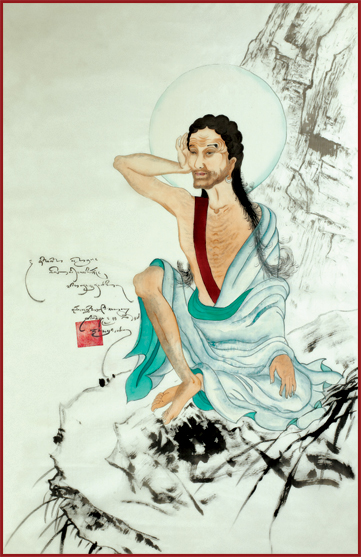Milarepa Day
February 21, 2016 @ 8:00 am - 5:00 pm
Milarepa Day
February 21st
8:00 AM to 5:00 PM
Join us for Milarepa Day!
This all day reading of The Rain of Wisdom is open to the public. The day begins with opening the Milarepa Sadhana and ends with closing it. Thus silence throughout the day is encouraged.
Participants can join in at any time of the day.
Since we presently only have a few copies, please bring along your own copy of The Rain of Wisdom books, they should bring them. By reading the dohas and stories in The Rain of Wisdom we connect to the powerful Kagyu lineage of devotion, courage, and insight.
Lunch break from 12:30 to 2pm.
Trungpa Rinpoche writes in his Foreword to The Rain of Wisdom:
The sense of dedication and exertion that is expressed in the life examples and songs of our Kagyü forefathers is something one can never forget. The Practice Lineage of the Kagyü tradition inspires one to become fully involved in a heartfelt connection with the teachings. From my childhood until the present day, each time I open The Rain of Wisdom and read a few passages it makes me appreciate the hardships that our forefathers endured for the sake of future generations such as ourselves.
The Kagyü tradition is said to be the most stubborn and honest in following its heritage. We take delight in our heritage. Doubt, challenge, hesitation—in brief, any form of second thoughts—are not regarded as obstacles, but rather as fuel to push us further and cause our devotion and heartfelt longing to blaze, to increase our intense desire to follow the example of our forefathers. So we, as Kagyüs, have thrived on the transmissions of our forefathers, and sustained and nourished ourselves in reading and reciting their vajra songs along with their life stories. […]
The readers of this book should reflect on the value and the wisdom which exist in these songs of the lineage in the following ways. First there are the life examples of our forefathers to inspire our devotion. There are songs which help us understand the cause and effect of karma and so illuminate the path to liberation. There are songs which give instruction in relative bodhicitta, so that we can realize the immediacy of our connection to the dharma. Some are songs of mahamudra and transmit how we can actually join together bliss and emptiness through the profound methods of coemergence, melting, and bliss. Other songs show the realization of Buddha in the palm of our hand. […]
These vajra dohas of the Kagyü forefathers are read annually in the celebration of the parinirvana of Milarepa […]. Students are also advised to read this book for instructions when their life is filled with disruption and uncertainty and neurosis. […] These songs do provide a kind of staircase of liberation. They actually enable us to interrupt our perpetual subconscious gossip, awaken ourselves on the path, and energize ourselves so that we can help others.
The songs of Tilopa point out the indivisibility of samsara and nirvana so that whatever arises is neither rejected nor accepted and we can recognize naked and raw coemergent wisdom on the spot.
The songs of Naropa bring realization of one taste, so that pain and pleasure are no longer connected with hope and fear.
The songs of Marpa Lotsawa describe how to establish a relationship with samsaric society, when to join in and when to transcend. These songs of the great Lotsawa instruct us in going beyond our body and mind neurosis, so that we can realize the unity of synchronized mind and body and thus become great warriors.
The songs of Milarepa tell us how we can free ourselves of both loneliness and claustrophobia through the extraordinary ascetic exertion of joining together nadi, prana, and bindu.
The songs of Gampopa inspire us in the supreme samadhi that quells neurotic tendencies. As it is said in the Samadhirajasutra, by achieving ultimate samatha-vipasyana and realizing the great bliss, we can follow all the stages of the path.
The songs of the Karmapas enable us to transcend hope and fear. Through total devotion, the blessings of auspicious coincidence are realized, so that we become genuine dharmic people.
The songs of other lineage holders point out to us the guru in our mind as one taste, and emptiness and compassion as a way to soften ourselves into decent human beings. They arouse in us the realization that cause and effect of karma is inevitable and bring the revulsion and renunciation that come from seeing that the samsaric scheme is futile and impermanent. Many of these songs act to clear obstacles and generate exertion in practice. […]
The essence of all the songs can be epitomized by the four dharmas of Gampopa. These are:
1. one’s mind becomes dharmic;
2. that dharma practice becomes path;
3. in following that path, confusion is removed;
4. having removed confusion, everything dawns as wisdom.
The first dharma is the ground, where our mind becomes dharmic so that we and the dharma are no longer separate entities. We develop true renunciation and have a sense of revulsion towards samsara.
The second dharma is the path. When our mind goes along with the dharma, the dharma becomes path, and any obstacles, whether extreme or ordinary, become a part of our journey.
The third dharma is the fruition. As the journey is taking place, the process of the journey liberates us from confusion and anxiety. We are delighted by our journey and we feel it is good.
The fourth dharma is the total vision. When we are able to overcome confusion and anxiety, even our anxiety is not regarded as antidharma or antipath. Cosmic wakefulness takes place.



